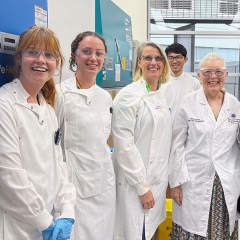A critical target in the war against obesity which may lead to improved treatments has been identified in a world first by a research team from UQ's Institute for Molecular Bioscience (IMB).
Obesity is recognised by the World Health Organisation as one of the top ten global health problems. It is the leading cause of heart disease, cancer and stroke - the top three causes of death in the USA, and also causes hypertension and diabetes.
IMB's Professor George Muscat said obesity had reached epidemic proportions as poor diet and sedentary living had equalled tobacco as the leading cause of death in the US and Australia was expected to follow this trend.
"Our work shows that activation of the gene, called PPAR-delta, in muscle cells increases fat (lipid) metabolism and the production of HDL or 'good' cholesterol," Professor Muscat said.
"This is an important breakthrough for the treatment of obesity because it identifies a 'drugable' gene that plays a key role in increasing metabolic rate and reducing cellular energy stores in muscle cells."
PPAR-delta is abundantly expressed in muscle, which accounts for 40% of the total body weight and is a primary site of sugar and fat metabolism. With diet and fat metabolism the most significant factors in controlling weight gain, PPAR-delta has a significant role in the blood lipid profile, and insulin sensitivity (glucose tolerance).
"Drugs that selectively activate PPAR-delta would obviously be very useful in the treatment of obesity and related conditions," he said.
"Current anti-obesity drugs are only moderately effective and are aimed at central appetite suppression, and reduced fat absorption. Our research opens up new strategies and targets for the development of fat burning drugs that increase the metabolic rate."
He said obesity leads to syndrome X, a disorder that includes elevated levels of triglycerides and LDL (bad) cholesterol, low levels of HDL (good) cholesterol and hypertension. These are cardiovascular risk factors for diseases such as arteriosclerosis and type II diabetes.
"One in five people in the US are clinically obese, and 65% of US adults are overweight meaning their health is at risk and representing a significant public health burden."
The anti-obesity drug market was greater than US$426 million in 2000 and expected to grow into billion dollar market by 2010.
Professor Muscat's work appeared in the prestigious journal Molecular Endocrinology published by the US Endocrine Society.
Anti-obesity gene flexes its muscle
9 Dec 2003



